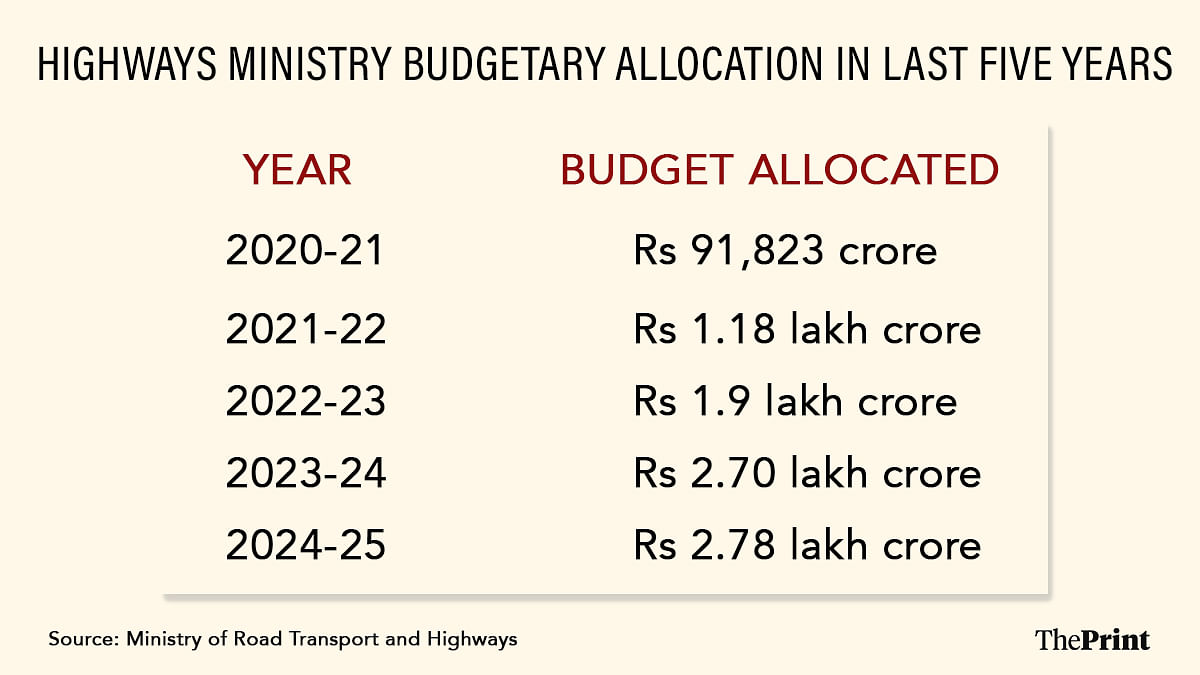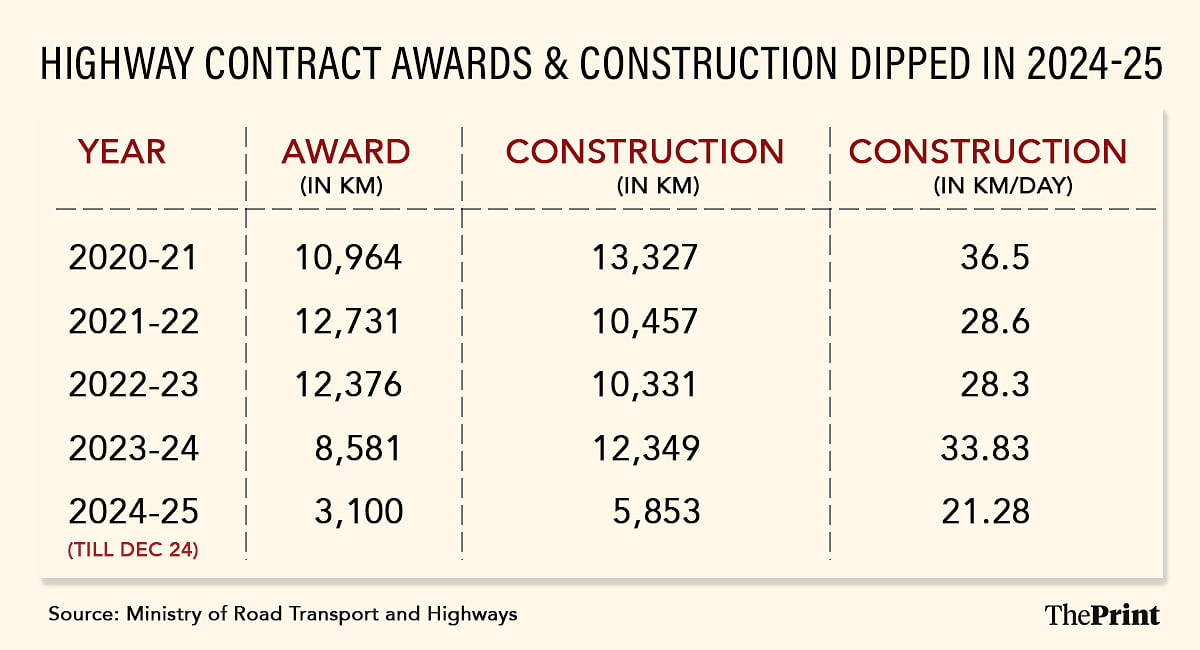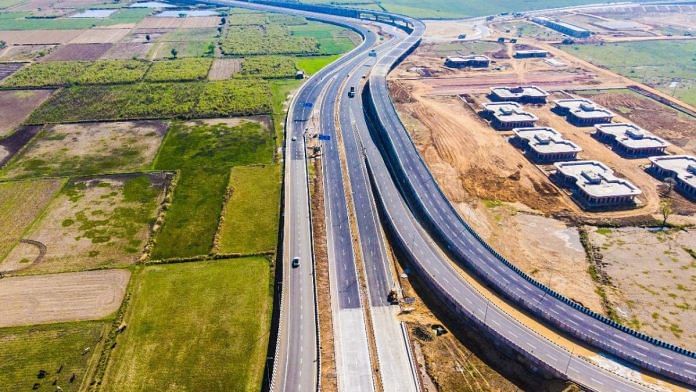New Delhi: The highways sector is going through a downturn of sorts, with the pace of awards as well as construction dipping in the current fiscal. However, the government is not unduly worried, ThePrint has learnt, and is looking at it as a “course correction” after Bharatmala, its flagship programme to build national highways, saw massive cost and time overrun.
Senior government officials, including from the Ministry of Road Transport and Highways (MoRTH) told ThePrint that, having learnt “hard lessons”, the ministry has decided to “tread cautiously” even if it means a reduction in the pace of awarding projects and construction in the 2025-2026 fiscal year.
Under the first phase of Bharatmala, launched in 2017, the Cabinet approved Rs 5.35 lakh crore for building 34,800 km of highways. But by 2023, contracts for approximately 26,500 km had been awarded, while the project cost had doubled to over Rs 10.6 lakh crore.
Of this, only 18,180 km length has been completed at a cost of approximately Rs 5 lakh crore—almost equal to the total project cost. The original deadline for Phase-I was September 2023.
This led the finance ministry to halt the approval of the remaining stretch of Bharatmala projects that had yet to be bid on. Phase II of the umbrella programme, which envisaged developing an additional 40,000 km of national highways, has already been scrapped.
The cautious approach is likely to reflect in the 1 February Union Budget with the highways sector unlikely to see a big hike in allocation for the 2025-2026 financial year (FY), one of the government officials, who did not want to be named, said.
In the 2024-25 budget, the highway sector was allocated Rs 2.72 lakh crore, a 3 percent increase from the Rs 2.64 lakh crore allocated in 2023-24.

“We are aware that the pace of award as well as construction will go down a bit for the time period. But we are very clear that the speed of construction and award should not be an excuse for giving a go by to rules,” a senior government official, who did not want to be named, told ThePrint.
“The frenzy to award projects without doing due diligence had other fallout too, including several projects going into arbitration.”
A road ministry official said the highways ministry has already changed its strategy and decided to go for a corridor-based approach instead of launching an umbrella highway programme like Bharatmala.
“Approximately 8,000 km of Bharatmala Phase I projects were left. They have been picked up and depending on their feasibility will be approved as separate, individual road corridors. We are on track to approve 11-12 new road corridors for execution by March 2025,” the official added.
Dip in the awarding of projects started from 2023
While the awarding of road projects witnessed a dip from 2023 onwards—from 3,111 km in the first nine months of 2023-24 FY to 3,100 km in the same period in 2024-2025 FY, construction dropped from 6,216 km in the first nine months of 2023-2024 FY to 5,853 km in 2024-2025 FY.

A second road ministry official, who did not want to be named, told ThePrint that while the awarding of projects will be way short of the target of of 10,500 km, they are hopeful of meeting the construction target of 10,400 km set for this fiscal.
Data provided exclusively to ThePrint by the credit ratings agency India Ratings & Research (Ind-Ra) reflects the slowdown trend. It showed that the value of tenders announced in the road sector—a measure of the government’s intent to increase capital expenditure (capex) in this sector—has drastically fallen in this financial year up to December 2024.
The value of tenders announced in the road sector fell to Rs 3.6 lakh crore in the first nine months of this financial year, 46 percent lower than in the full year of 2023-24. It is this reduction that has primarily driven the fall in the overall value of tenders announced during April-December 2024 across sectors.
Despite this, Ind-Ra noted in its report that the roads sector still accounts for 30 percent of the tenders floated in the infrastructure space, but that there was a noticeable trend in the focus shifting to other sectors.
“There is a substantial increase in the number of tenders announced across other segments,” Ind-Ra said. “Water (including irrigation), power (including generation and distribution) and real estate lead by factors such as the conclusion of general elections and pent-up lower announcements during previous quarters, especially from central and state governments.”
One of the issues leading to a slowdown in capex in roads and other key sectors is that there is a limited capacity for these sectors to absorb the increased spending.
“The government spends in limited areas,” Madan Sabnavis, chief economist at the Bank of Baroda told ThePrint in an interview.
“About 70 percent of the central government’s capex is on roads, railways, and defence. There are limits to this. The government can build metro stations, Vande Bharat trains and modernise tracks, but there is a limited amount of land on which there are tracks. So how much more can be spent on this? Can we execute so many more highways? The execution part is also very important.”
Rigorous scrutiny of projects at pre-approval stage
The second road ministry official underlined the fact that project approvals will now go through more rigorous scrutiny to ensure that cost and time overruns are minimal.
“Each project will be scrutinised at multiple levels,” the official added.
Elaborating on this, the official said that moving forward, after a project is sanctioned, if its cost goes up by 20 percent, the nodal agency will have to go to the Cabinet to get the revised cost approved.
The second official also said that the ministry is also preparing a masterplan of road projects to be taken up. “It will not only specify how many road projects will be taken up but the cash flow required for the next three or four years till it is completed.”
The highways ministry is also trying to set a system in place that will ensure compliance. “All road building agencies, be it the NHAI (National Highways Authority of India) or NHIDCL (National Highways and Infrastructure Development Corporation Limited) work under the ambit of rules and regulations,” the official said.
This, the official said, is to avoid a repetition of what happened with the Bharatmala programme.
Besides, the official added, from now on, all greenfield alignments will be approved by the road ministry. Earlier, in the Bharatmala programme, NHAI had bypassed the ministry and had approved new alignments. This had led to cost escalation of several projects.
Last year, the Comptroller and Auditor General of India (CAG) had also flagged glaring irregularities in the implementation of Bharatmala Phase-I. These included instances where projects were developed “based on deficient cost-benefit study or without getting detailed project reports prepared”.
(Edited by Sanya Mathur)
Also Read: In limbo since 2019, AP’s Polavaram dam project back in motion after Centre’s Rs 2,300 crore advance







Firstly, the consultants who prepare the Detailed Project Reports (DPR) must be held accountable. The DPRs for infrastructure projects provide wildly exaggerated figures. Figures and numbers are cooked up in favour of the project. Egregiously optimistic estimates, far removed from the realities of life, are made.
An example of this are the metro projects across cities. Except Kolkata and Delhi, none of rhe metro projects have crossed even 25% of the projected ridership volume.
It’s high time the agencies/consultants preparing the DPRs are held accountable and penalised.
Secondly, the land acquisition issue must be looked into. In every single infrastructure project, delays are primarily due to land acquisition issues. This leads to severe cost overruns. A political consensus must be arrived at to ensure swift and smooth procedures of land acquisition.
Investment in defence is guided by strategic considerations. However, road and rail, accounting for the bulk of government capital expenditure must pay for themselves, as commercial enterprises. Be able to service debt. Railways recently wanted 70,000 crores of loans to be converted into a grant, ie, written off.